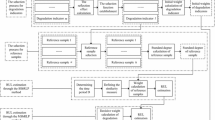Abstract
Online remaining-useful-life (RUL) estimation is an effective method with respect to ensuring the safety of complex-huge systems. Generally, current methods assume a specific degradation model when degradation values are observed in the initial degradation phase. However, this assumption may not always be robust enough owing to the often-ambiguous inherent incipient-degradation characteristic. Therefore, besides model-parameter uncertainty, the uncertainty of the degradation model is worth examining in online RUL estimations. In this paper, a Bayesian-updated expectation-conditional-maximization (ECM) algorithm is adopted to address the uncertainty of prior parameters, and a modified Bayesian-model-averaging method is used to deal with the uncertainty of the degradation model. Then, simulation studies are conducted to analyze the effectiveness of the proposed fusion algorithm. Results suggest that the Bayesian-updated ECM algorithm and modified Bayesian-model-averaging method effectively address the associated uncertainties of model parameters and the degradation model itself. Finally, we apply the proposed fusion algorithm to predict the RUL of a gyroscope.
Similar content being viewed by others
References
Zhang J X, Hu C H, He X, et al. A novel lifetime estimation method for two-phase degrading systems. IEEE Trans Rel, 2019, 68: 689–709
Si X S, Li T M, Zhang Q. A general stochastic degradation modeling approach for prognostics of degrading systems with surviving and uncertain measurements. IEEE Trans Rel, 2019, 68: 1080–1100
Si X S, Li T M, Zhang Q, et al. Prognostics for linear stochastic degrading systems with survival measurements. IEEE Trans Ind Electron, 2020, 67: 3202–3215
Si X S, Hu C H, Li T M, et al. A joint order-replacement policy for deteriorating components with reliability constraint. Sci China Inf Sci, 2021, 64: 189203
Xi J, Wang C, Liu H, et al. Completely distributed guaranteed-performance consensualization for high-order multiagent systems with switching topologies. IEEE Trans Syst Man Cybern Syst, 2019, 49: 1338–1348
Si X S, Li T M, Zhang Q, et al. An optimal condition-based replacement method for systems with observed degradation signals. IEEE Trans Rel, 2018, 67: 1281–1293
Hu C H, Pei H, Si X S, et al. A prognostic model based on DBN and diffusion process for degrading bearing. IEEE Trans Ind Electron, 2019. doi: https://doi.org/10.1109/TIE.2019.2947839
Zhang Z, Si X, Hu C, et al. Degradation data analysis and remaining useful life estimation: a review on Wiener-process-based methods. Eur J Oper Res, 2018, 271: 775–796
Hudak S J J, Saxena A, Bucci R J, et al. Development of Standard Methods of Testing and Analyzing Fatigue Crack Growth Rate Data. Westinghouse R&D Center Westinghouse Electric Corporation, 1978
Meeker W Q, Escobar L A. Statistical Methods for Reliability Data. New York: John Wiley & Sons, Inc., 1998
Ye Z S, Xie M, Tang L C, et al. Semiparametric estimation of Gamma processes for deteriorating products. Technometrics, 2014, 56: 504–513
Li Z J, Deng Y M, Mastrangelo C. Model selection for degradation-based Bayesian reliability analysis. J Manufacturing Syst, 2015, 37: 72–82
Peng C-Y, Tseng S-T. Mis-specification analysis of linear degradation models. IEEE Trans Rel, 2009, 58: 444–455
Peng C-Y, Tseng S-T. Statistical lifetime inference with Skew-Wiener linear degradation models. IEEE Trans Rel, 2013, 62: 338–350
Ramos A A. The minimum description length principle and model selection in spectropolarimetry. Astrophys J, 2006, 646: 1445–1451
Bozdogan H. Akaike’s information criterion and recent developments in information complexity. J Math Psychol, 2000, 44: 62–91
Nguyen K T P, Fouladirad M, Grall A. Model selection for degradation modeling and prognosis with health monitoring data. Reliab Eng Syst Saf, 2018, 169: 105–116
Abdessalem A B, Dervilis N, Wagg D, et al. Model selection and parameter estimation in structural dynamics using approximate Bayesian computation. Mech Syst Signal Process, 2018, 99: 306–325
Si X S, Wang W, Chen M Y, et al. A degradation path-dependent approach for remaining useful life estimation with an exact and closed-form solution. Eur J Oper Res, 2013, 226: 53–66
Meng X L, Rubin D B. Maximum likelihood estimation via the ECM algorithm: a general framework. Biometrika, 1993, 80: 267–278
Chen N, Tsui K L. Condition monitoring and remaining useful life prediction using degradation signals: revisited. IIE Trans, 2013, 45: 939–952
Chakraborty S, Gebraeel N, Lawley M, et al. Residual-life estimation for components with non-symmetric priors. IIE Trans, 2009, 41: 372–387
Gebraeel N Z, Lawley M A, Li R, et al. Residual-life distributions from component degradation signals: a Bayesian approach. IIE Trans, 2005, 37: 543–557
Nitithumbundit T, Chan J S K. An ECM algorithm for skewed multivariate variance Gamma distribution in normal mean-variance representation. 2015. arXiv: 1504.01239
van Dyk D A, Meng X, Rubin D B. Maximum likelihood estimation via the ECM algorithm: computing the asymptotic variance. Stat Sin, 1995, 5: 55–75
Zhang X, Yan X. A new statistical precipitation downscaling method with Bayesian model averaging: a case study in China. Clim Dyn, 2015, 45: 2541–2555
Hoeting J A, Madigan D, Raftery A E, et al. Bayesian model averaging: a tutorial. Stat Sci, 1999, 14: 382–401
Gebraeel N, Elwany A, Pan J. Residual life predictions in the absence of prior degradation knowledge. IEEE Trans Rel, 2009, 58: 106–117
Si X S, Chen M Y, Wang W, et al. Specifying measurement errors for required lifetime estimation performance. Eur J Oper Res, 2013, 231: 631–644
Acknowledgements
This work was supported by National Key R&D Program of China (Grant No. 2018YFB1306100) and National Natural Science Foundation of China (Grant Nos. 61922089, 61773386, 61833016, 61903376, 61673311).
Author information
Authors and Affiliations
Corresponding author
Rights and permissions
About this article
Cite this article
Yu, Y., Si, X., Hu, C. et al. Online remaining-useful-life estimation with a Bayesian-updated expectation-conditional-maximization algorithm and a modified Bayesian-model-averaging method. Sci. China Inf. Sci. 64, 112205 (2021). https://doi.org/10.1007/s11432-019-2724-5
Received:
Accepted:
Published:
DOI: https://doi.org/10.1007/s11432-019-2724-5




